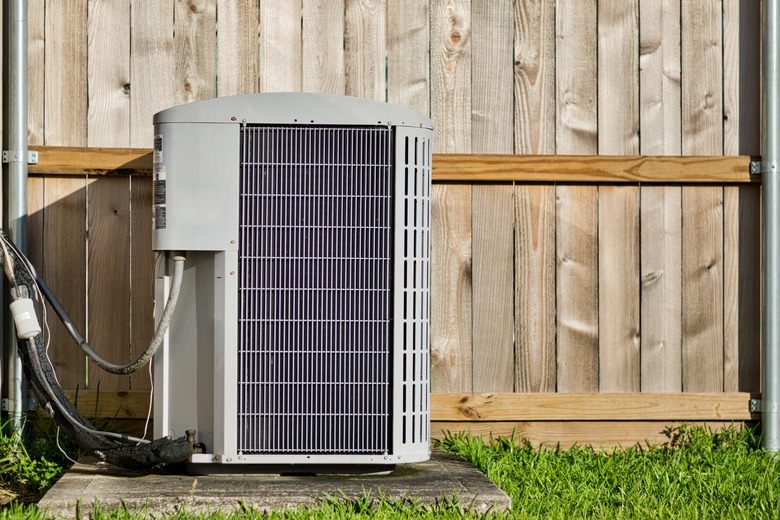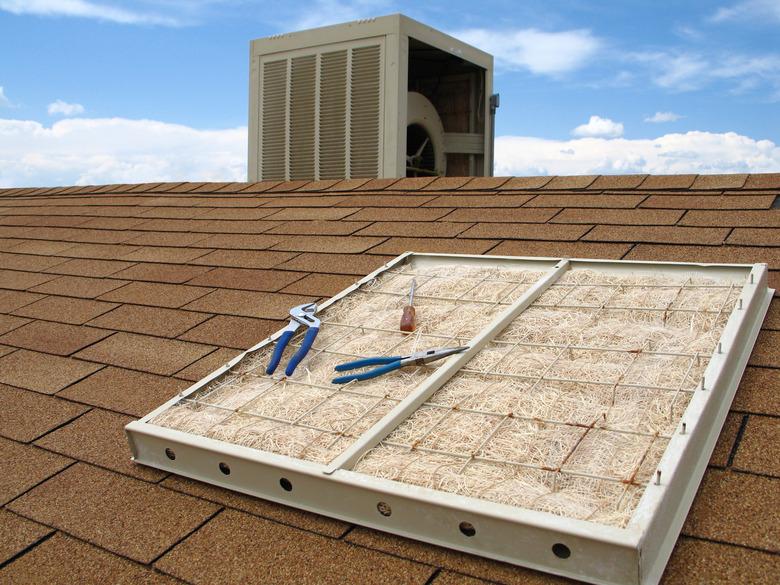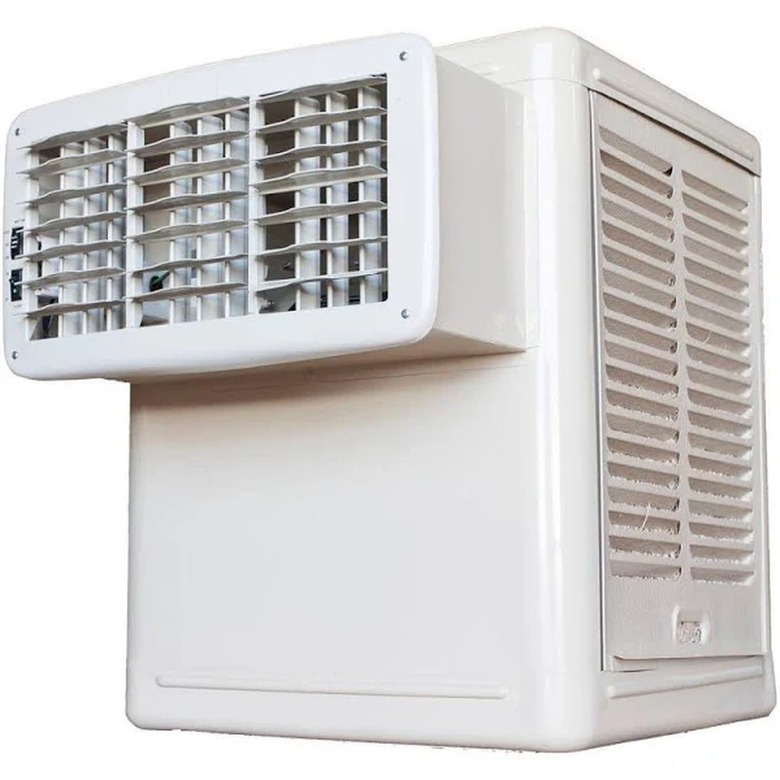Swamp Coolers Vs. Air Conditioners: Which Is Best For Cooling Your House?
We may receive a commission on purchases made from links.
Swamps coolers and air conditioners aren't the only ways to cool your house, but they are two of the best ways, and home cooling is more important for homeowners everywhere than it ever has been. The National Oceanic and Atmospheric Administration (NOAA) reports that 2020 was the second-hottest year on record — just behind 2016 — and 2021 may be on track to break the all-time record.
Home cooling is a balancing act between keeping your family comfortable and limiting energy usage since every kilowatt of electricity you use for cooling comes from a power generation plant, many of which burn fossil fuels that contribute to global warming, increasing the need for even more cooling. Swamp coolers are definitely more energy efficient than air conditioners, using about one-half as much electricity, and they are cheaper to install, but they aren't the answer for everyone.
Swamp coolers don't work well in humid climates, where they can actually make the indoor air feel hotter, and in places where they do work well, they don't cool as deeply as air conditioners. Air conditioning systems, on the other hand, dehumidify as they cool, which makes them ideal for humid climates but not so great for dry climates. They work best in sealed buildings, which means people in the building are always breathing processed air. These are just some of the factors to consider when choosing between evaporative cooling and air conditioning.
Tip
If you live in a dry and arid part of the country, a swamp cooler is a cost-effective alternative to an air conditioner for home cooling. Swamp coolers don't work well in humid climates, which includes most places in the United States east of the Rocky Mountains.
How Swamp Coolers and Air Conditioners Work
How Swamp Coolers and Air Conditioners Work
Swamp coolers are more properly known as evaporative coolers because they work by the evaporation of water. Inside a swamp cooler housing, you'll find an air circulation fan and a water pump, which are the only two components that need electricity. The water pump circulates water from a pan and sends it through fibrous pads, and when the blower circulates air through the pads, the evaporating water cools the air, which is then circulated into the building.
Air conditioners work in somewhat the same way. They also technically rely on evaporative cooling, but evaporation happens inside a system of tubing and coils, and it's supercharged by a refrigerant and a powerful compressor. The refrigerant is designed to absorb more heat than water when it evaporates, and it releases that heat outdoors when the compressor pressurizes it back into a liquid. Water vapor from a swamp cooler can also condense back into a liquid and release heat, but when this happens, it's usually inside the HVAC ductwork or the house, and it counteracts the cooling effect of the system.
A central A/C system and a swamp cooler both utilize blowers that draw equal amounts of electricity, but the reason air conditioners get lower points for energy efficiency is because of the large amount of electricity consumed by the compressor. Air conditioning is far more common in the United States than evaporative cooling, accounting for 6 percent of national electricity usage and pumping 117 tons of carbon dioxide into the air every year. A/C units consume on average 13 kWh of electricity per year per square foot of cooling area, but swamp coolers typically consume only half of that, or about 6.5 kWh.
Humidity Problems With Swamp Coolers
Humidity Problems With Swamp Coolers
After considering the energy-efficiency statistics, homeowners might think the decision to install a swamp cooler instead of an air conditioner is a no-brainer, but it unfortunately isn't that simple. The propensity for evaporative coolers to release humid air into the environment can be a major plus in dry climates, but it's a drawback in humid regions where humidity is consistently above 50 percent, and it's a fatal flaw in regions in which humidity is regularly above 70 percent.
If the relative humidity is super low — around 20 percent — a swamp cooler can turn an outdoor temperature of 80 degrees into an indoor temperature of 63 degrees, or an overall difference of 17 degrees. But if the relative humidity is 70 percent, only 4 degrees of cooling can be realized.
Additional humidity can make a room feel more comfortable if the relative humidity is low and is desirable, but it can create all sorts of problems in places where the humidity is high. One of the most serious issues is that it promotes the growth of mold, mildew, and other pathogens that thrive in moist environments. A 2017 study published by the National Center for Biotechnology Information found that homes with swamp coolers in the Great Basin desert region — one of the areas most suitable for swamp coolers — had a higher concentration of fungal pathogens that cause allergic reactions than those that had air conditioners.
Humidity Problems With Air Conditioners
Humidity Problems With Air Conditioners
Besides the facts that they are more expensive to install and they cost more to operate, air conditioners create the opposite humidity problem. An air conditioner dehumidifies as it cools. The reduction in humidity is a blessing in humid environments, but it can make conditions uncomfortable in an already dry environment, producing scratchy skin and even affecting wood flooring boards and other wooden objects in the home.
Unlike a swamp cooler, which should be operated with windows partially open to create airflow for extra cooling, an air conditioner works best if all the doors and windows are closed. When you set the thermostat for an air conditioning unit to a comfortable temperature, you can be sure of a steady supply of dry air, and if the indoor air is already dry, you might need to run a humidifier to add moisture. That increases the cost of running an A/C system, which is already higher than that of running a swamp cooler.
Despite the fact that they dehumidify, air conditioners can still create mold problems in humid environments unless they get the maintenance they need. Mold can grow on the duct walls and at the registers where cold air and warm air meet, and the temperature differential causes moisture to condense out of the warm air. Air conditioner drain lines can also harbor mold when they get blocked or when they aren't cleaned regularly.
Maintenance and Potential Problems
Maintenance and Potential Problems
Swamp coolers need more frequent maintenance than air conditioners, but the maintenance tasks are simple enough for most homeowners to accomplish, although some ladder work may be involved to access rooftop and wall-mounted units. These tasks include:
- Cleaning or replacing the cooling pads, which should be done monthly during periods of high use.
- Emptying and cleaning the water pan at the base of the unit.
- Lubricating the blower motor and cleaning the blower blades.
- Lubricating and adjusting the float in the water pan to ensure a steady stream of fresh water.
Unlike evaporative coolers, central air conditioners have an indoor unit (usually housed inside a furnace or a separate air handler) and an outdoor unit where the compressor is located. The main maintenance tasks that homeowners can do themselves include cleaning or replacing the air filter in both units, cleaning the drain line and evaporator coil in the indoor unit, and cleaning the condenser coil and condenser fins in the outdoor unit. These tasks are necessary to prevent performance issues and maintain good air quality in the home.
An air conditioning system is more complex than a swamp cooler, so more can go wrong, and because an air conditioner is a type of refrigeration system, repairs usually have to be completed by a licensed HVAC technician. These repairs might include replacing failing compressor seals, fixing refrigerant leaks, or replacing corroded coils. Both air conditioning and swamp cooling systems use thermostats for temperature control, and many malfunctions can be traced to improper thermostat settings. These types of problems are less likely to occur with a swamp cooler because swamp cooler thermostats are simpler in design than those for A/C units and are easier to understand and program.
Is a Swamp Cooler Worth It to Save Energy?
Is a Swamp Cooler Worth It to Save Energy?
No matter how you look at it, a central air conditioner is a more costly investment than a swamp cooler. The price for a new air conditioner is between $1,500 and $3,000, while a new swamp cooler costs between $350 and $1,500. The average cost to install an air conditioning system is around $5,500, and it could be higher depending on how much ductwork is required, while the typical installation cost for a swamp cooler is about $2,500. (And don't forget that an air conditioner costs about twice as much to operate as a swamp cooler does.)
Given these cost considerations, there must be a reason air conditioners outnumber swamp coolers in North American homes, and in fact, there are several:
- Swamp coolers don't work everywhere. In fact, except for a small swath of land along the Canadian border, they are pretty much ineffective in any part of the United States east of the Rocky Mountains.
- Swamp coolers don't cool as deeply as air conditioners. In ideal humidity conditions, the best you can expect from a swamp cooler is a 30-degree reduction in temperature, but the norm is between 15 and 20 degrees. Air conditioners can achieve and maintain lower temperatures, but the tradeoff is that you have to keep the house sealed and breathe processed air instead of fresh air.
- Swamp coolers require a steady supply of water — from 1 to 20 gallons per hour of run time depending on the size of the unit and the ambient humidity and temperature. That can be a problem in the arid regions for which swamp coolers are most suited.
- Swamp coolers can make the house smell musty. Without proper maintenance, swamp coolers can seriously affect air quality to the point that people in the house begin complaining of persistent musty or fishy odors.
- Windows have to be left open when a swamp cooler is running. This allows cool air to circulate. That's a selling point for some people, but it means that warm air can come in through the windows as well as dust, air pollution, and smoke from fires.
- You can't use a swamp cooler during a storm. Swamp coolers won't work well during a rainstorm or immediately after one because rain always fills the air with humidity. Some people get around this by installing traditional air conditioners in the windows and running them when conditions aren't right for evaporative cooling. You can also run a swamp cooler in fan-only mode when the air is humid. This won't provide any cooling, but it will keep your house ventilated.
- Swamp coolers have to be properly shut down for the winter. This process includes draining the water, removing the pads, doing a deep cleaning, and covering the housing. To winterize an air conditioner, you just need to shut it off and cover the housing.
Despite all these drawbacks, a swamp cooler is a good investment in the proper climate, provided you are willing to give it all the TLC it needs. Like a solar electricity generating system, it lightens the load on the power grid, and in an increasingly energy-intensive world, that's a consideration that can trump all the others.
References
- National Oceanic and Atmospheric Administration: 2020 Was Earth's 2nd-Hottest Year, Just Behind 2016
- Energy.gov: Evaporative Coolers
- Energy.gov: Home Cooling Systems
- Premier Industries: What's More Cost-Effective, Swamp Cooling or Air Conditioning?
- Newair: Common Swamp Cooler Complaints – How to Troubleshoot Your Evaporative Cooler
- National Center for Biotechnology Information: Microbial rRNA Sequencing Analysis of Evaporative Cooler Indoor Environments Located in the Great Basin Desert Region of the United States
- HomeAdvisor: How Much Does It Cost To Install A Swamp Cooler?
- HomeAdvisor: How Much Does It Cost To Install Central Air?
- HeatTalk: Do Evaporative (aka Swamp) Coolers Work In My Area? Find Out With Our Evaporative Cooler Humidity Chart
- Vankool: Top 11 Frequently Asked Questions (FAQs) | Swamp Cooler


